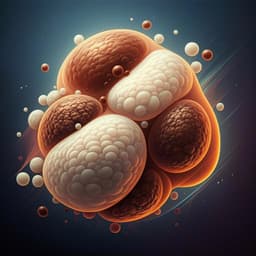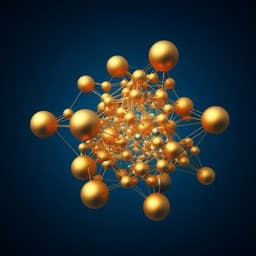
Chemistry
Improved electrochemical conversion of CO₂ to multicarbon products by using molecular doping
H. Wu, J. Li, et al.
This innovative research unveils a breakthrough strategy to enhance the electrochemical conversion of CO₂ into valuable multicarbon products. By modifying a bimetallic silver-copper catalyst with aromatic heterocycles, this method significantly boosts the production of ethanol and ethylene with impressive efficiencies. The compelling findings were conducted by a collaborative team of experts.
Playback language: English
Introduction
The escalating levels of atmospheric CO₂ necessitate the development of Carbon Capture, Utilization, and Storage (CCUS) technologies. Electrochemical CO₂ reduction to hydrocarbons using renewable energy is a promising CCUS approach, offering a circular carbon economy. While progress has been made in converting CO₂ into single-carbon products (like CO and CH₄), producing higher-value, energy-dense multicarbon products (ethylene, ethanol, etc.) remains a significant challenge. Copper (Cu), is uniquely effective in catalyzing the formation of these multicarbon products from CO₂. Improving the selectivity and efficiency of this reaction is crucial. Current strategies for optimizing CO₂ reduction to C₂ and C₂⁺ molecules include alloying, surface doping, ligand modification, and interface engineering. This study explores a novel approach using molecular engineering principles to modify the active sites of a Cu-based catalyst, aiming for controlled design of electrocatalytic materials. Specifically, it investigates the effect of modifying the oxidation state of copper—a factor known to improve CO₂RR performance and C₂⁺ production—through surface functionalization with electron-withdrawing aromatic heterocycles.
Literature Review
Significant advancements have been made in the electrochemical reduction of CO2, particularly in achieving high selectivity toward single-carbon products like CO and methane. However, the production of multicarbon products, which offer higher energy density and market value, remains less efficient. Researchers have explored various strategies to enhance the selectivity and yield of C2+ products, including alloying copper with other metals such as silver (Ag) and modifying the copper surface via doping with other elements or through the addition of organic molecules. Studies have shown that altering the oxidation state of copper can significantly impact the CO2 reduction reaction (CO2RR) performance, particularly in favoring the formation of C2+ species. The use of organic modifiers, such as N-aryl pyridinium salts, imidazole, and thiols, has also been reported to influence reaction selectivity by stabilizing intermediates, modifying proton diffusion, or acting as redox mediators. The functionalization of catalyst surfaces with alkyl chains has shown promise in suppressing the competing hydrogen evolution reaction (HER) by introducing hydrophobic regions. This prior research provided the foundation for the current study’s investigation into surface functionalization with electron-withdrawing aromatic heterocycles to tune copper's oxidation state and improve CO2RR selectivity.
Methodology
The researchers fabricated functionalized bimetallic Ag-Cu catalysts using a two-step process. First, Ag and Cu were electrodeposited onto gas diffusion electrodes (GDEs) creating a porous structure where Cu preferentially deposits on Ag. The optimal Ag:Cu ratio was determined to be 15% at. Ag. Subsequently, the catalyst surface was modified via dip coating with various thiol molecules: thiadiazole (N₂SN), triazole (N₃N), 1-propanethiol (C₃), and cysteamine (C₂N). The success of the functionalization was verified using several techniques: changes in water contact angle (indicating surface modification), energy-dispersive X-ray spectroscopy (EDS) and high-angle annular dark-field scanning transmission electron microscopy (HAADF-STEM) and electron energy-loss spectroscopy (EELS) mapping (confirming the uniform distribution of functional groups), Raman and Fourier transform infrared (FTIR) spectroscopy (detecting the characteristic Raman and FTIR signatures of grafted molecules), and X-ray photoelectron spectroscopy (XPS) (identifying the presence of S and N bonds associated with the functional groups). Density functional theory (DFT) calculations were performed to determine the most stable adsorption configuration of thiadiazole on the Cu(111) surface. Electrochemical testing was conducted in both H-cell and membrane electrode assembly (MEA) electrolyzer configurations. In the H-cell, argon and CO₂-saturated 0.5 M KHCO₃ electrolytes were used. Product analysis was performed using nuclear magnetic resonance (NMR) and gas chromatography (GC) to quantify the Faradaic efficiency (FE) for various products (H₂, CO, formate, CH₄, and C₂⁺). The electrochemically active surface area (ECSA) of Cu and Ag was determined using Pb underpotential deposition. Electrochemical impedance spectroscopy (EIS) explored charge transfer processes. Operando Raman and X-ray absorption spectroscopy (XAS) provided insights into the reaction mechanism under operational conditions. In the MEA electrolyzer, the catalyst was integrated into a 4 cm² flow cell, and liquid products were collected using a cold trap. The CO₂ flow rate was varied to study its effect on performance. Extended stability tests in the MEA were also performed to assess the long-term performance of the functionalized catalyst.
Key Findings
The functionalization of the Ag-Cu catalyst with thiadiazole (N₂SN) and triazole (N₃N) significantly enhanced the CO₂ reduction reaction (CO₂RR) performance. In H-cell experiments, these functionalized electrodes exhibited higher current densities and lower onset potentials compared to the pristine catalyst and those functionalized with short alkyl or aminoalkyl chains. The Faradaic efficiency (FE) for C₂⁺ products (ethylene and ethanol primarily) was significantly increased (57.3% and 51.0% at −1.2 V vs. RHE for N₂SN and N₃N, respectively, compared to 18% for the pristine catalyst). The selectivity towards C₂⁺ products also increased. In contrast, the functionalization with short alkyl chains did not enhance activity and showed minimal C₂⁺ production. Operando Raman and XAS revealed that the electron-withdrawing nature of N₂SN and N₃N led to the formation of Cuδ⁺ species (0 < δ < 1) on the catalyst surface, This Cuδ⁺ favored the adsorption of CO in the atop configuration, a key intermediate for C-C coupling and subsequent multicarbon product formation. The intensity of the Raman signals associated with atop-bound CO correlated strongly with the FE for C₂⁺ products. A volcano-shaped relationship was observed between the FE for C₂ products and the ratio of atop-bound CO to bridge-bound CO. In MEA electrolyzer tests, the N₂SN-functionalized catalyst demonstrated exceptional performance, achieving a FE for C₂⁺ products of 80 ± 1% and a full-cell energy efficiency of 20.3% at a specific current density exceeding 260 mA cm⁻². This high performance was maintained for over 100 h of continuous operation. The study also explored the influence of CO₂ flow rate on performance. The optimal CO₂ flow rate was identified as 10 sccm, balancing the supply of CO₂ with efficient dimerization on the catalyst surface. Finally, the enhanced C₂⁺ selectivity was attributed to the electron-withdrawing ability of the aromatic heterocycles rather than solely to hydrophobicity effects.
Discussion
This study successfully demonstrates a novel molecular engineering strategy to enhance the electrochemical conversion of CO₂ to multicarbon products. The key to the improved performance lies in the controlled p-doping of the copper surface by electron-withdrawing aromatic heterocycles. This tuning of the copper oxidation state to Cuδ⁺ (0 < δ < 1) promotes the adsorption of CO in the atop configuration, crucial for C-C coupling. The strong correlation between the oxidation state of Cu, the presence of atop-bound CO, and the FE for C₂⁺ products supports the proposed mechanism. The findings highlight the importance of precise control over the catalyst's electronic structure in achieving high selectivity and efficiency for CO₂RR. The high Faradaic efficiency (80%) and energy efficiency (20.3%) achieved in the MEA electrolyzer demonstrate the practical potential of this approach for sustainable C₂⁺ production. The long-term stability of the functionalized catalyst further strengthens its potential for real-world applications.
Conclusion
This work provides a significant advancement in electrochemical CO₂ reduction by demonstrating the successful application of molecular engineering to precisely control the electronic properties of a bimetallic catalyst. The use of aromatic heterocycles as surface modifiers to achieve a specific oxidation state of copper enhances the selectivity and efficiency of CO₂ conversion to valuable multicarbon products. The high performance and stability observed in both H-cell and MEA electrolyzer setups showcase the potential of this approach for industrial-scale CO₂ utilization. Future research could explore different aromatic heterocycles with varying electron-withdrawing strengths to further optimize the catalyst's performance and investigate the effects of other factors, such as temperature and pressure, on the CO₂RR process.
Limitations
While the study demonstrates excellent performance and stability, several limitations should be noted. The study primarily focused on ethylene and ethanol production, and the investigation of other multicarbon products could be expanded. Further optimization of the electrodeposition and functionalization processes could potentially improve the reproducibility and scalability of the catalyst synthesis. A more detailed understanding of the long-term degradation mechanisms of the functional groups under continuous operation in the MEA electrolyzer would benefit future development efforts.
Related Publications
Explore these studies to deepen your understanding of the subject.







